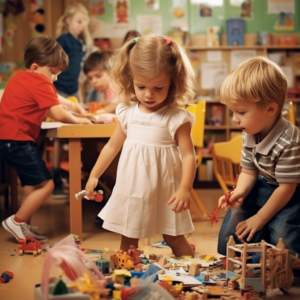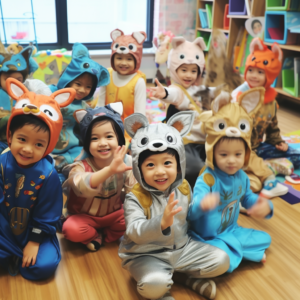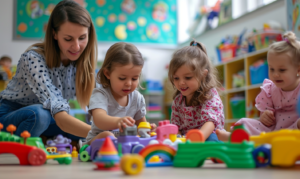Intro: Decode the Early Years Foundation Stage and its Significance in Your Child’s Education
The Early Years Foundation Stage (EYFS) is a critical part of the education system in the United Kingdom, aimed at children from birth to five years old. It’s a framework that not only impacts your child’s time at nursery but also lays the foundation for their future learning and development. For parents, understanding the EYFS can sometimes feel like deciphering a complex code. This article aims to unravel this intricate framework and help you comprehend its significance in your child’s educational journey.
Summary: A Guide to the EYFS Framework, its Components, and What It Means for UK Nurseries and Parents
This blog post will delve into the intricacies of the EYFS framework. From its principles and history to its founding, we’ll weigh its pros and cons and even provide some case studies to demonstrate its real-world applications. Armed with this information, you’ll be better equipped to make educated decisions about your child’s early years education in the UK.
The Principles of EYFS
The EYFS framework is built upon four overarching principles:
- A Unique Child: Recognises that every child is an individual who learns and develops at their own pace.
- Positive Relationships: Focuses on forging strong relationships between children and their parents, caregivers, and educators.
- Enabling Environments: Highlights the importance of creating stimulating environments that support and enhance a child’s learning experiences.
- Learning and Development: Emphasises a structured approach to education, with seven areas of learning that include both academic subjects and holistic development.
The History and Founding of EYFS
The EYFS framework came into force in September 2008 and was revised in 2012 and 2017, with the latest update in 2021. It was designed to consolidate various existing early-years programmes into one unified approach. The framework was founded with the intent of creating a standardised educational experience for all children before they enter compulsory schooling at age five.
Pros and Cons of EYFS
Pros
- Standardisation Across the Board
- Uniform Quality: The EYFS framework aims to create a standardised level of early-years education across the United Kingdom. This ensures that regardless of socio-economic background or geographic location, children should have access to a uniform standard of early learning.
- Ease of Transition: The standardisation also makes it easier for children to transition from one educational setting to another, as the EYFS framework will be consistent.
- Holistic Approach to Development
- Well-Rounded Growth: The framework considers all aspects of a child’s development, not just academics. This includes social skills, emotional growth, and physical development.
- Foundational Skills: Early mastery of these multiple facets of development sets a strong foundation for a child’s subsequent education and life skills.
- Strong Parental Engagement
- Informed Decision-Making: EYFS promotes a partnership between parents and educators. Parents are better informed and can be more actively involved in their child’s education.
- Enhanced Outcomes: Research shows that when parents are engaged, children tend to do better academically and socially.
- Built-in Assessment and Evaluation
- Continuous Monitoring: The framework includes assessment milestones known as the ‘Early Learning Goals,’ which allows for continuous monitoring of a child’s progress.
- Early Intervention: This allows for timely interventions if a child appears to be falling behind in any area.
Cons
- One-Size-Fits-All Approach
- Limited Customisation: Critics argue that the EYFS framework may not suit the individual learning styles or pace of all children, particularly those with special educational needs.
- Reduced Autonomy: Teachers may feel restricted in adapting the curriculum to fit their unique classroom needs.
- Resource-Intensive Implementation
- Financial Constraints: Especially for smaller nurseries or those in disadvantaged areas, the requirements for equipment, space, and specialised training can be costly.
- Administrative Burden: The need for continuous assessment and documentation can put additional administrative strain on educators.
- Limited Flexibility and Creativity
- Structured Learning: Some critics feel the structured approach to education can limit creativity, both for teachers in how they teach and for students in how they learn.
- Risk of Standardised Testing: The focus on meeting ‘Early Learning Goals’ could potentially lead to a ‘teaching to the test’ mentality, although this is less of an issue at the EYFS stage compared to later educational phases.
- Potential for Inequality
- Parental Engagement: While the emphasis on parental involvement is generally positive, it may inadvertently disadvantage children whose parents are unable, for various reasons, to engage to the same extent as others.
- Access to Resources: Not all educational settings have the same level of resources to fully implement the EYFS framework, which could perpetuate inequalities.
Understanding these nuanced pros and cons can help parents, educators, and policymakers make more informed decisions about implementing and engaging with the EYFS framework.
Case Study 1: A Rural Nursery in Wales
Background
This nursery is situated in a quaint Welsh village and is fortunate to have a significant amount of outdoor space, including a forested area, a pond, and multiple gardens.
Implementation of EYFS: Phase-by-Phase
- Planning: The staff initially conducted a site evaluation to determine how to maximise their outdoor spaces within the context of the EYFS ‘Enabling Environments’ principle.
- Curriculum Design: They integrated outdoor activities into daily schedules, connecting them with other EYFS learning areas such as ‘Understanding the World’ and ‘Physical Development.’
- Parental Involvement: Parents were briefed on the outdoor emphasis and were encouraged to send children in appropriate clothing for various weather conditions.
- Continuous Assessment: Teachers regularly evaluated children’s engagement and learning through these outdoor activities, making adjustments as needed.
Outcomes
- Social Skills: Children displayed improved abilities to share, negotiate, and resolve conflicts.
- Physical Development: Increases in motor skills were observed, including balancing, jumping, and hand-eye coordination.
- Academic Readiness: Teachers noted that children exhibited enhanced concentration and listening skills, which are critical for formal schooling.
Lessons Learned
The principle of ‘Enabling Environments’ can be optimally utilised when an institution’s unique attributes are aligned with EYFS objectives.
Case Study 2: An Inner-City Nursery in London
Background
Located in an urban setting, this nursery had to grapple with constraints like limited space and resources.
Implementation of EYFS: Phase-by-Phase
- Initial Struggles: The nursery initially tried to adapt their limited space to fit all EYFS areas of learning but found it overwhelming.
- Shift in Focus: They decided to hone in on the ‘Positive Relationships’ principle by engaging parents more actively.
- Parent Workshops: They conducted workshops and seminars teaching parents how to support their child’s learning at home.
- Feedback Loops: Regular parent-teacher meetings were scheduled to discuss the child’s progress and set new goals.
Outcomes
- Parental Engagement: A noticeable uptick in parents actively participating in their child’s learning activities.
- Holistic Development: Improved social and emotional skills among children, besides academic improvements.
- Teacher Satisfaction: Educators found it more rewarding to collaborate closely with parents.
Lessons Learned
Even when resources are constrained, focussing on relationship-building can yield positive results, fulfilling the EYFS principle of ‘Positive Relationships.’
Case Study 3: A Specialist Nursery for Children with Special Needs
Background
Located in the Midlands, this nursery caters to children with special needs, including autism spectrum disorders and Down syndrome.
Implementation of EYFS: Phase-by-Phase
- Initial Assessment: The educators began by assessing each child’s individual needs to understand how to adapt the EYFS framework effectively.
- Curriculum Adaptation: Learning pathways were adjusted to include various therapeutic interventions, such as speech therapy and occupational therapy.
- Parental Consultation: Parents were closely consulted to tailor individualised plans.
- Review and Revise: The nursery regularly reviewed the adapted plans to ensure they were meeting each child’s developmental needs.
Outcomes
- Individual Growth: Children displayed improvement in individualised goals, such as communication skills or emotional regulation.
- Parent Satisfaction: Parents reported feeling highly satisfied with the tailored approach and noted marked improvements at home.
- Inclusion: The nursery successfully created an inclusive environment where every child could thrive.
Lessons Learned
Flexibility is crucial when applying the EYFS framework to special educational needs settings, yet the core principles can still serve as a foundational guide.
By exploring these case studies in depth, one gains a multifaceted understanding of how the EYFS framework is not a one-size-fits-all model but rather a versatile tool that can be adapted to various circumstances and needs.
Conclusion
The Early Years Foundation Stage (EYFS) framework is a cornerstone of early education in the UK. While it’s not without its challenges, its principles offer a balanced approach to holistic child development. By understanding the EYFS better, parents can make more informed decisions that can positively impact their children’s educational trajectory.
Now that you’re armed with this knowledge, you’re well-equipped to navigate the exciting, and sometimes confusing, world of your child’s early education.













